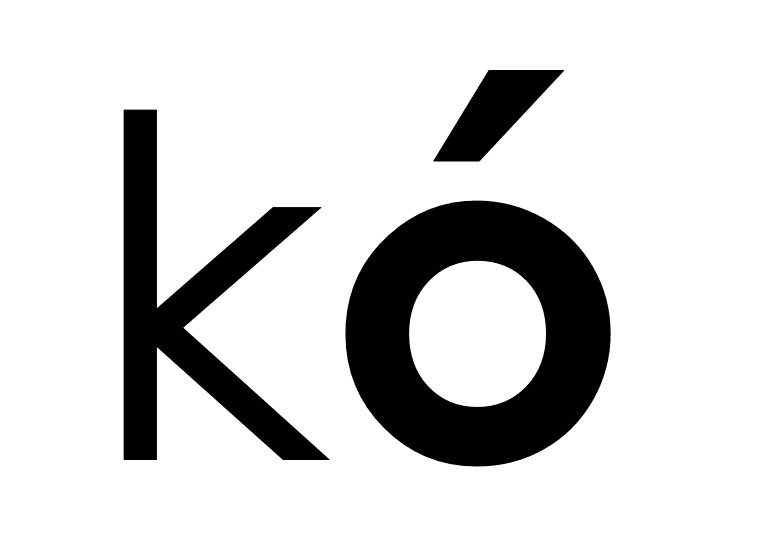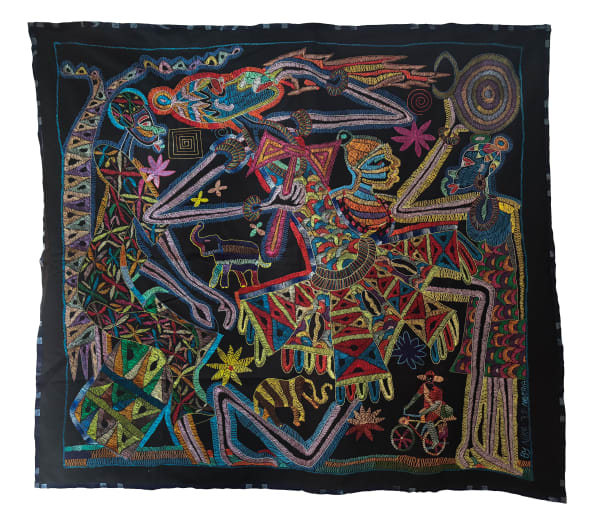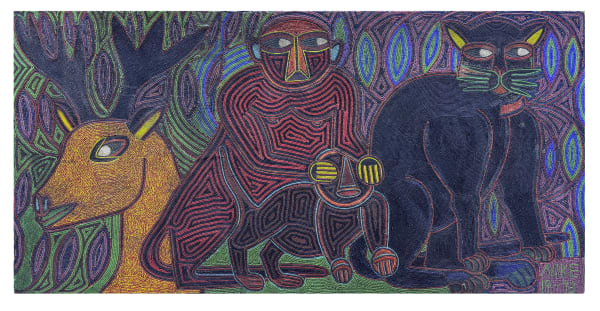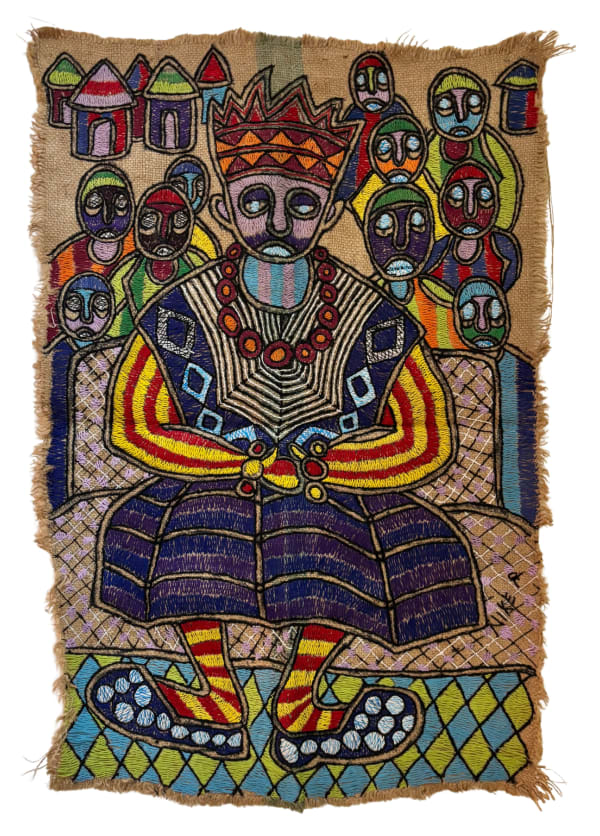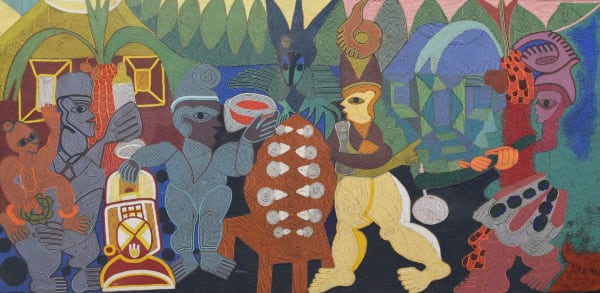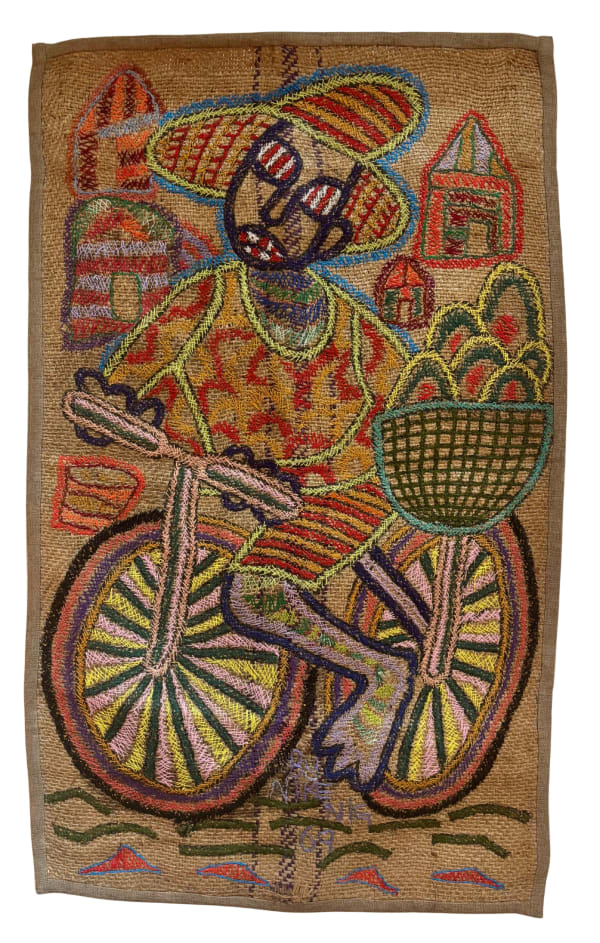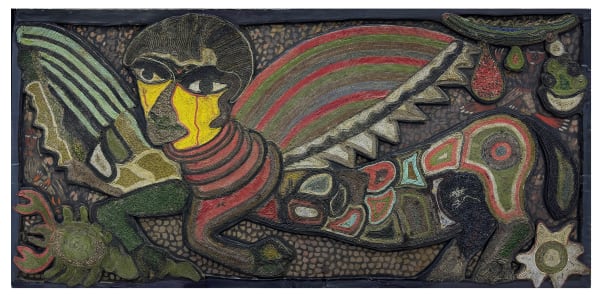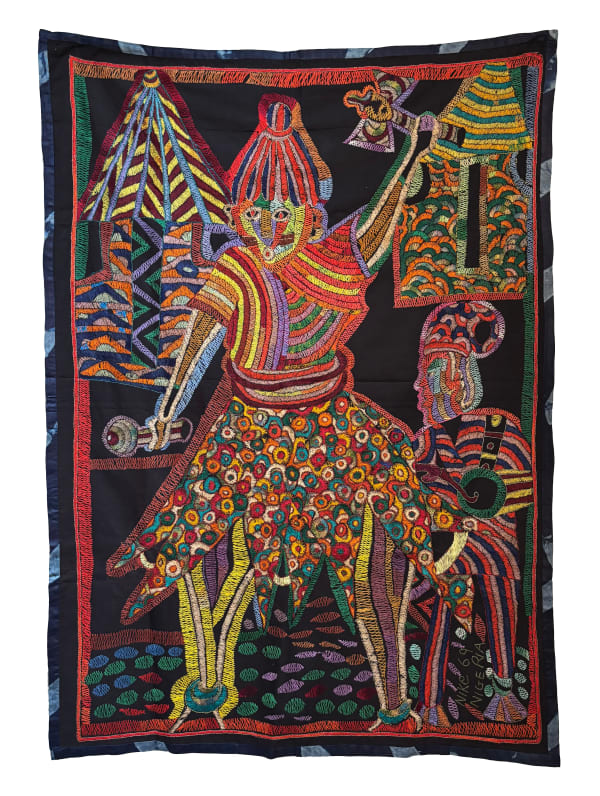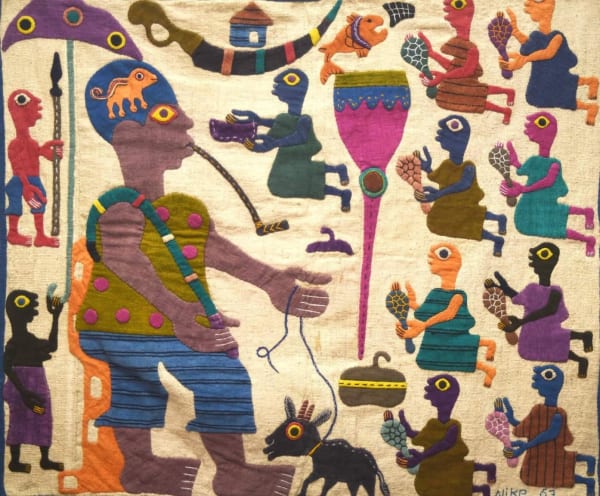Nike Davies-Okundaye Nigeria, b. 1951
Chief Nike Davies-Okundaye is an internationally renowned batik and Adire textile artist. She is a central figure in the revival of traditional Nigerian arts with a career that has spanned more than five decades.Nike’s artistic career emerged as part of the Osogbo Art Movement of the 1960s in newly independent Nigeria, re-imagining traditional Yoruba art and spirituality through a modernist lens. Using vivid colors and bold geometric patterns, her work explores narratives of family, daily life, womanhood, and Yoruba folklore —drawing from both personal experiences and cultural memory.
Her work is held in the permanent collections of major institutions such as the Museum of Modern Art, New York; the Smithsonian National Museum of African Art; Guggenheim Abu Dhabi; the British Library; the Victoria and Albert Museum; the American Museum of Natural History; Princeton University Art Museum; Iwalewa-Haus, University of Bayreuth; and the Hood Museum of Art, Dartmouth College.
Born in 1951 in Ogidi, Nigeria, Nike Davies-Okundaye is a fifth-generation textile artist, raised in the lineage of Yoruba women who passed down the traditions of Adire dyeing, embroidery, and weaving. With no formal art education, Nike began learning from her great-grandmother at the age of six. Inspired by the cultural significance of these practices as a form of “women’s art” passed through generations, she has dedicated her life to preserving and evolving these traditions. Her work frequently explores Adire, a Yoruba resist-dye technique using indigo on hand-painted cloth. These designs carry layered cultural and historical meanings, forming complex patterns recognized within Yoruba visual culture.
Nike’s early embroidery was often stitched onto burlap sacks, their rough edges left uncropped. These works depict narrative scenes featuring archetypal Yoruba community figures—farmers, market women, drummers, and palm wine tappers—as well as deities such as Sango and Olokun. The striking contrast between monochromatic backgrounds and the vivid, almost psychedelic hues of her threads conjures a surreal, dream-like atmosphere.
In her beadwork, Davies-Okundaye often draws on personal experience, embedding autobiographical elements through metaphor and symbolism. Despite working in secrecy during her early years, Nike’s career has spanned over five decades. She became an apprentice to Susanne Wenger, the Austrian artist active in Osogbo, a key center for Nigerian art and culture in the 1960s. In 1968, she held her first solo exhibition at the Goethe-Institut in Lagos. By 1974, Nike was among ten African artists selected to tour the United States, conducting workshops and lectures across all fifty states. She has since served as a guest lecturer on traditional textile techniques at institutions worldwide, including Harvard University.
Nike is a tireless advocate for women in the arts and craft industries. Affectionately known as “Mama Nike,” she is the founder and director of four art centers in Nigeria that offer free training in visual, musical, and performing arts. She also established Nike Art Gallery in Lagos—the largest private art gallery in Africa—housing over 8,000 works across five floors. In 2000, Nike was invited by the Italian government to train young Nigerian sex workers in Italy in traditional crafts. This initiative helped over 5,000 women learn Adire production, weaving, and other art forms, empowering them to build sustainable livelihoods. For this work, she received recognition from the United Nations and was awarded one of Italy’s highest national honors for using art to address social issues. In 2004, she was appointed to the UNESCO Committee of the Nigerian Intangible Cultural Heritage Project, and in 2005, the National Commission for Museums and Monuments of Nigeria awarded her a certificate of excellence for her contributions to cultural preservation.
Nike holds the chieftaincy titles of the Yeye Oba of Ogidi-Ijumu and the Yeye Tasase of Oshogbo.
-
 The Market Square I, 2025
The Market Square I, 2025 -
 The Market Square II, 2025
The Market Square II, 2025 -
 The pattern of adire, 1990
The pattern of adire, 1990 -
 Osun, The Goddess of the River, 1987
Osun, The Goddess of the River, 1987 -
 The Brain, 1984
The Brain, 1984 -
 Ghost Dancer, 1982
Ghost Dancer, 1982 -
 Iya Ibeji (Mother of twins), 1982
Iya Ibeji (Mother of twins), 1982 -
 Marriage of the Gods, 1982
Marriage of the Gods, 1982 -
 The Ghost Dancer, 1982
The Ghost Dancer, 1982 -
 Untitled, 1982
Untitled, 1982 -
 Aroko series V, 1981
Aroko series V, 1981 -
 Aroko series VII, 1980
Aroko series VII, 1980 -
 Marriage with God, 1980
Marriage with God, 1980 -
 The finger that feeds never lacks, 1979
The finger that feeds never lacks, 1979 -
 Untitled, 1979
Untitled, 1979 -
 Husband and wife in the village, 1978
Husband and wife in the village, 1978 -
 The Donkey Rider, 1978
The Donkey Rider, 1978 -
 The Mushroom of Life, 1977
The Mushroom of Life, 1977 -
 Woven in Love, 1977
Woven in Love, 1977 -
 Market women, 1976
Market women, 1976 -
 Farmer, 1974
Farmer, 1974 -
 Strength of a woman, 1973
Strength of a woman, 1973 -
 The lost cat, 1973
The lost cat, 1973 -
 Osun, 1972
Osun, 1972 -
 The Osun Goddess , 1972
The Osun Goddess , 1972 -
 Ghost, 1971
Ghost, 1971 -
 The Black Angel, 1971
The Black Angel, 1971 -
 Where love reigns, 1971
Where love reigns, 1971 -
 Meditation, babalawo, 1970
Meditation, babalawo, 1970 -
 The palmwine tapper and ayo game, 1969-1970
The palmwine tapper and ayo game, 1969-1970 -
 Drummer, 1969
Drummer, 1969 -
 Farmer returning from the farm, 1969
Farmer returning from the farm, 1969 -
 Flying Angel, 1969
Flying Angel, 1969 -
 Osun Goddess, 1969
Osun Goddess, 1969 -
 Sango, God of Thunder, 1969
Sango, God of Thunder, 1969 -
 The return of the farmers, 1969
The return of the farmers, 1969 -
 Animal World, 1968
Animal World, 1968 -
 Elephant, 1968
Elephant, 1968 -
 The Wood Seller, 1968
The Wood Seller, 1968 -
 African ceremony, 1967
African ceremony, 1967 -
 Going to the market, 1967
Going to the market, 1967 -
 Loving family, 1967
Loving family, 1967 -
 Sango Performer, 1967
Sango Performer, 1967 -
 The lost cat, 1967
The lost cat, 1967 -
 The Musicians and Dancers, 1964
The Musicians and Dancers, 1964
